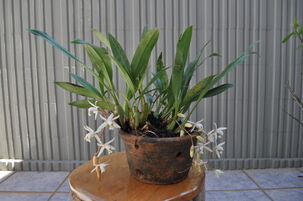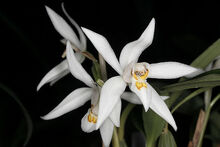| |||||||||||||||||

Coelogyne corymbosa is a species of Coelogyne.
Description Edit
Edit
Plants bloom from fall to winter with up to 5 flowers. Flowers last about two weeks long and are 7 cm wide. Flowers are fragrant.
Distribution Edit
Edit
Plant is found growing on rocks in the lower montane forest in Nepal, Bhutan, northeastern India, and China at elevations of 1400 to 3000 meters
Culture Edit
Edit
Plants are usually grown in baskets. Plant grows from cool temperatures in partial shade. Water regularly during the summer, about once every two days and gradually reduce in the winter. Water about once every two to three weeks and gradually increase watering as new roots begin to show. Pot in a well drain medium. Pot in a plastic or clay pot with a mix of fine fir bark, tree fern fibers, and perlite or pot in New Zealand sphagnum moss.
Naming Edit
Edit
Common name: The Umbrella-Like Coelogyne
Synonyms Edit
Edit
- Coelogyne taronensis Hand.-Mazz. 1922
- Pleione corymbosa (Lindl.) Kuntze 1891
References Edit
Edit
- Hill, Cindy. "Coelogyne:Sparkiling Stars of Asia." Orchid Digest Vol. 72-2 April, May, June 2008: 60-76.
Rhizome somewhat rigid, 3-4 mm in diam., with dense, brown, scaly sheaths. Pseudobulbs rather dense, less than 1 cm apart from each other, bright yellow or brownish yellow and strongly wrinkled when dried, oblong-ovoid or nearly rhombic-oblong, (1-)2-4.5 cm × 6-13 mm, with 2 leaves at apex and several sheaths at base; sheaths lucid, ovate, 1.5-2.5 cm, papery. Leaf blade oblong-oblanceolate to obovate-oblong, 4.5-15 × 1-3 cm, subleathery, adaxially with raised transverse veinlets, apex often acuminate; petiole 1-2 cm. Inflorescence proteranthous to synanthous, 7-15 cm (elongated when fruiting), embraced by sheaths below middle; raceme 2- or 3(or 4)-flowered; floral bracts caducous. Flowers white or slightly tinged with yellowish green, with 4 yellow eyelike blotches surrounded by reddish orange. Sepals oblong-lanceolate, 18-22(-35) × 7-8 mm, apex acute or obtuse; lateral sepals somewhat narrower than dorsal sepal. Petals linear-lanceolate, 18-22 × 2.5-4 mm; lip subovate, 16-28 × 12-25 mm, 3-lobed; lateral lobes erect, suborbicular or nearly subovate; mid-lobe ovate or ovate-lanceolate, 6-9 mm; 2 or 3 low lamellae extending from base to mid-lobe. Column slightly arcuate, 10-20 mm, both sides winged; wings widened from base to apex, upper side ca. 1.7 mm wide on one side, apex obtuse. Capsule subobovoid, slightly trigonous, 2.2-5 × 0.9-1.3 cm. Fl. May-Jul, fr. next Jul-Nov. 2n = 38, 40.
On trees at forest margins or on humid cliffs; 1300-3500 m. S and SE Xizang, S and W Yunnan [Bhutan, NE India, Myanmar, Nepal].
CITIES category : Appendix II
References
1.Ref 1
2.Ref 2

No comments:
Post a Comment